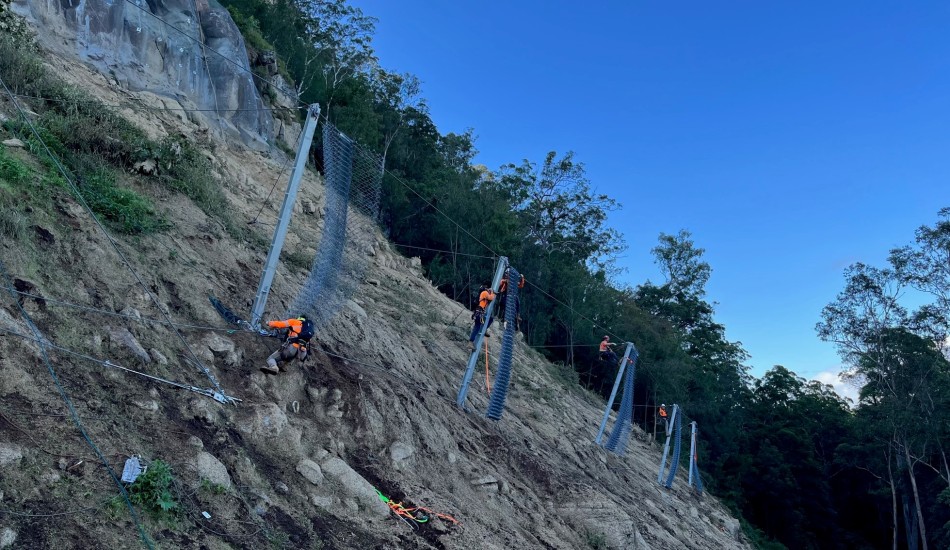
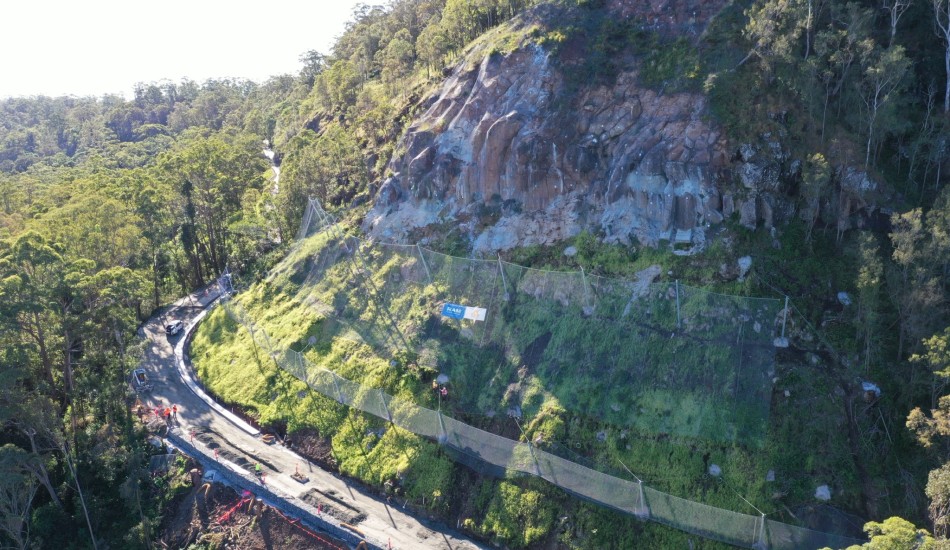
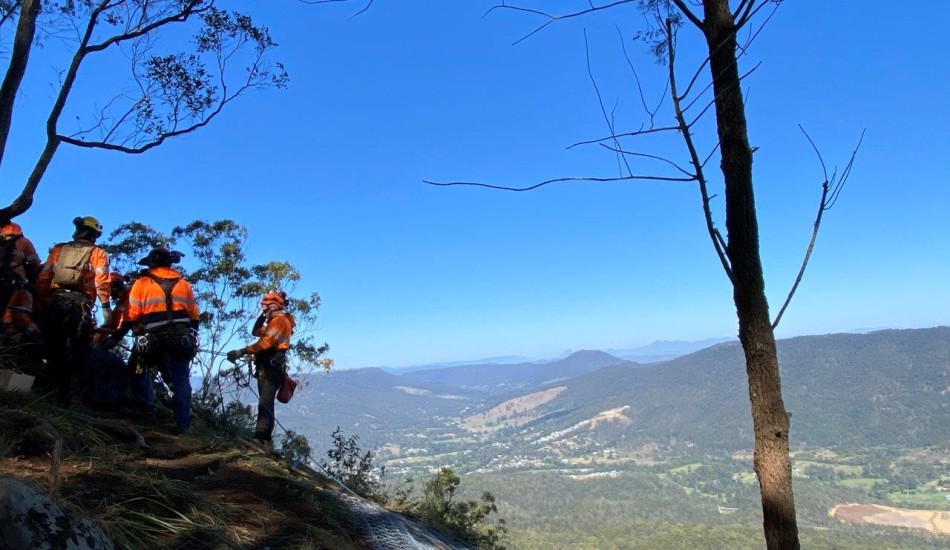
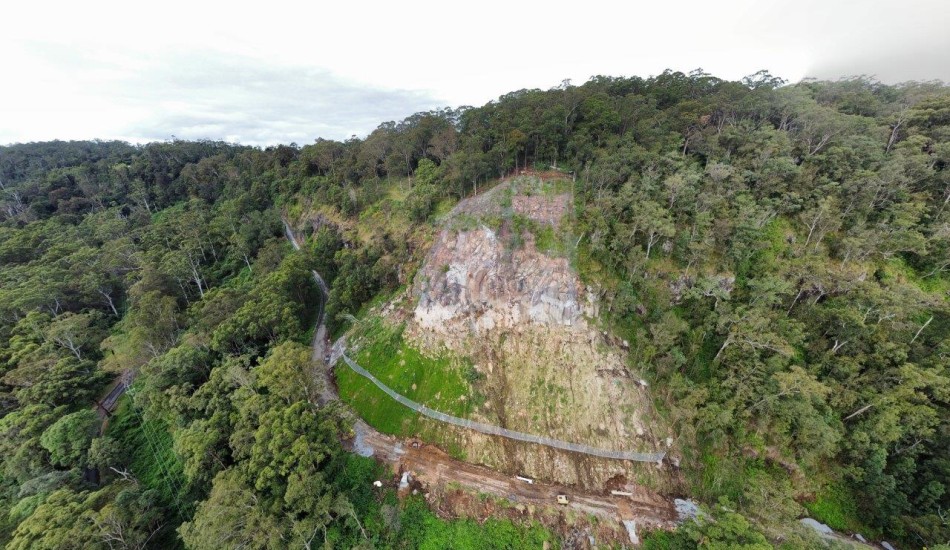
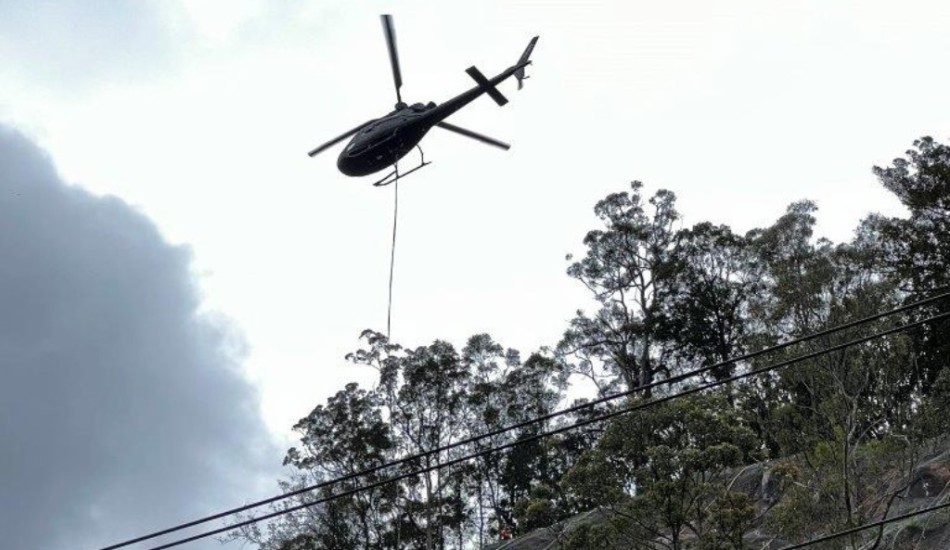
[PROJECTS]
The Department of Transport and Main Roads (TMR) engaged SEE Civil to restore Tambourine Mountain Road as part of its First Response Emergency Works Program. The road, affectionately known by locals as the ‘Goat Track‘, was damaged during significant rainfall in December 2020, which caused landslips along the corridor.
SEE Civil overcame the complexities of high-risk construction by using specialised equipment and work methods that improved project safety during the unprecedented recovery journey without compromising the timeline.
The project included sky cranes, drone technology, and tailored equipment to expedite delivery which meant the community regained access to the closed section of the road – eliminating the 45-minute detour and reconnection of essential services within the community.
Emergency services response timeframes were significantly improved and the innovation and construction methods employed by the project team have become the benchmark for TMR slope remediation projects.
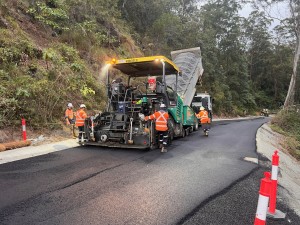
Safety was a critical focus for SEE Civil on the project due to the hazardous terrain conditions coupled with tropical weather conditions South East Queensland was experiencing during the project recovery timeframe.
The project achieved zero lost time injuries and implemented safety initiatives such as:
The High-Risk Permit to Work (HRPTW) was required prior to the start of every shift. Over the life of the project, the HRPTW evolved to consider more factors. Prior to any work occurring on the site the following personnel needed to review the permit.
Firstly, the site geotechnical engineer assessed ground conditions. Then the project manager and site supervisor provided input, the appropriate contractor was consulted with, and persons signed that they understood the cliff was deemed safe for the workforce to operate.
Following each rain event there was a requirement on the Permit to Work, that the site needed to be reviewed and inspected by both parties to ensure areas were safe.
The permit had a map of the work front to allow simple identification of the work zones and assisted in communicating this to the broader teams.
Being engaged on a D&C program for emergency works is challenging as the typical process for the project’s design, tendering, market input, planning and execution is expedited.
The project’s key focus was to restore an essential public asset and support the immediate recovery of a community following the disaster. Consideration of the constraints of the project was assessed throughout the project’s life through ongoing investigation, monitoring, and observation.
Works commenced on the project in parallel with design in an environment with challenging geotechnical conditions. Design decisions, considering the project’s conditions and environment, are a process that can take several months. Investigations were completed as construction progressed to overcome time constraints and expedite the program.
Construction works started as the program and design were being developed, which enabled the project team to make timely decisions and ensure the design was considered with the information available.
Engagement and consultation with the construction team and designers were integral factors for the project’s successful design and construction, achieving a critical path and obtaining clear directions on the project’s priorities.
The Tamborine Mountain Road project posed many logistical construction challenges that needed to be addressed to undertake work activities safely. The project site could not be accessed by road, with workers and machines needing to rappel down the rock face utilising rock climbing and cabling techniques.
Drilling crews overcame tight work area challenges by using the following methods:
Civil crews overcame tight work area challenges by:
Working in tight work areas led to additional coordination and extended activity durations due to staging requirements.
In December 2020, a coastal trough brought significant rainfall to northeast New South Wales and southeast Queensland. The severe rainfall events caused minor and major land slips along Tamborine Mountain Road and other parts of the state.
In response to the disaster, local and state governments activated urgent recovery programs to restore essential public assets to support the immediate recovery of affected communities. Funding assistance was provided, jointly funded, through the Commonwealth-State Disaster Recovery Funding Arrangements (DRFA).
SEE Civil was engaged in July 2021 by the Department of Transport and Main Roads (TMR) under the First Response Emergency Works (FREW) program to restore the Tamborine Mountain Road – affectionately known by locals as the ‘Goat Track’.
This Tamborine Mountain Road recovery project included essential clean-up activities, works to secure the mountain side, and reconstruction of Tamborine Mountain Road. The design and construction elements were completed in collaboration with GHD, TMR and CGC. SEE Civil was responsible for finalising the design and construction components of the emergency reconstruction contract.
Funding eligibility was subject to SEE Civil reporting design validity, supported by geotechnical design investigations and design analysis.
The Issued for Construction (IFC) design adopted a passive rock dowel system and steel mesh drape to the upper slope, two fences to the colluvium mid-slope, gabion basket retaining wall to the downslope. Reconstruction works included stormwater systems, pavements, communication services, guardrail, kerbing, landscaping, signage, and line marking.
Following a series of geotechnical slope assessments and activity-based risk assessments, SEE Civil used a top-down construction methodology to stabilise the mountainside and install a series of catch fences. Securing the mountainside enabled the road level reconstruction works to be completed in a stable and safe environment.
Tamborine Mountain Road was closed for the project duration to enable works to be completed and ensure the safety of motorists and staff. A detour was in place with motorists needing to travel an additional 45 minutes to access the communities of Tamborine Mountain and Canungra. The community and interested stakeholders eagerly anticipated the expedited program and reopening of the road.
Logistic and access constraints influenced the construction methodology and planning. Traditional methods of construction were not feasible so developing innovative approaches to construction was a priority to complete works.
SEE Civil commenced drilling in September 2021 using sled-mounted drilling rigs and installed 3m 40/16mm hollow dowels around the basalt cliff and colluvium mid-slope. Due to access constraints on the mountain, rope access workers were required to carry each component down the slope manually. Over the life of the project, more than 1900m were drilled.
Anchoring and meshing were completed in February 2022. The project successfully installed approximately 250 anchors, more than 5700m2 of mesh, and used more than 25,000L of grout to affix the anchors.
Complex steel reinforced shotcrete was installed and was required to be applied through a series of fixed lines and boom pumps. A total volume of 190m3 of concrete was applied via 4.5m3 individual loads. Weight loads were restricted to 4.5m3 due to the steep terrain and access to the site.
Due to the limited road access and confined site, three helicopters were engaged to complete sky-lifts.
Catch fencing lifts were required to build a 4m-high rockfall catch fence which included 12 fence posts and a 9mLx 4mH purpose-built mesh panel. The lifts were required to install fencing components for the project and drape mesh. The attenuator fence comprised nine posts and a 15m-long 65/4mm diamond mesh drape.
The project and the rest of southeast Queensland were heavily affected by rainfall and wet delays during construction in early 2022. Rainfall seemed to intensify throughout the hinterland region, with rainfall forecasts typically being moderately under conservative.
Evolving design, logistics, environmental factors, and safety innovation challenged project delivery.
During project delivery, heavy rainfall and unprecedented weather events were ongoing. Given the cause of the initial slope failure was due to heavy rainfall, there was heightened awareness around slope stability, site safety and environmental mitigation.
The project recorded more than 3000mm of rainfall, impacting the program by 90 days. Despite these adverse conditions, Tamborine Mountain Road was successfully opened on time on 1 August 2022.

WE PRIDE OURSELVES ON THE KNOWLEDGE, SKILLS AND EXPERIENCE OF OUR PEOPLE.
SEE Group builds teams and workplaces where everyone can be their best.
